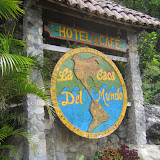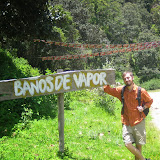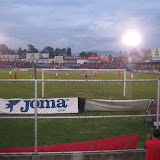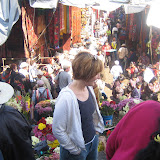Sunday, August 27, 2006
We ain't Chicken!
Saturday, August 26, 2006
La Casa Del Mundo
Thursday night, as we were packing, Martha came in to tell us that there might be a problem with our travels the next day. Once again, there were to be major protests near Xela at the major intersection just outside of town -- Cuatro Caminos. Sure enough, we had to go through that intersection on our way to Lake Atitlan. We are not exactly sure the details of the protest, but it had something to do with disagreements between teachers and the government over how many years of school were required for teachers to be certified. To get to this point, with weekly protests slowing down all major commerce, things must have been bad.
Rosi (Martha's daughter) had called with the news; to confirm, her son called his "connections" in the government to see what time the protests were going to take place. Much to our dismay, there were to go from 6am - 6pm. So much for our mid-day bus!
Luckily, and with Martha's help, we arranged for a cab to pick us up at 4:30am in hopes of catching a 5am bus. It all worked out in the end, though the 4 hour journey is worth its own story that is in the works...
Fast forward--
We eventually arrived at La Casa Del Mundo around 9:30am, in time for a fabulous breakfast followed by a much needed nap as we waited for check-in time. It's truly hard to describe just how nice the weekend was.
The setting was perfect. Each of the 15 rooms overlooked the lake. The balconies at water level were great for soaking in the sun or taking a cool swim. The beds -- words cannot describe the comfort, particularly the cloud-like pillows that we (I) had been longing for. Meals were AMAZING -- easily the best we have had on our trip, and the Chilean wine was equally as tasty. Dinner was served family style and we got to meet many other travelers, a few of whom confirmed just how small a world it really is. Kayaks were available for use. It was heavenly, and a perfect setting for our first anniversary!
Unfortunately, our budget wouldn't allow us to stay much longer...if we wanted to eat, that is. So we convinced ourselves to explore other cities around the lake, which has been great.
Enjoy the pictures of La Casa Del Mundo...
Wednesday, August 23, 2006
Cambiamos nuestros planes.
Wednesday, August 16, 2006
Los Vahos
The natural saunas there are fueled by veins of volcanic heat pumped right into our own private little room. The temperatur
We later learned from our host family that many indigenous people believe the saunas help detoxify the body; they also believe the vapors promote "let down" for breast milk, and often go to Los Vahos a few days after giving birth.
Friday, August 11, 2006
Especially for Tami and Sue: A Day In the Life
This is what a typical week day has been like for us these past five weeks. However, after next week, Robert and I head out to explore Guatemala and beyond.....
A Day in The Life of Bert and Liz Campbell
6:00 am- After hitting snooze for 10 minutes (yes, we do that here too!), Robert and I furiously finish our homework from the night before (for those of my college friends, you know my homework switch turns off around 9:00 pm).
7:12 am- I throw on a long-sleeved t-shirt, wrap my towel (it is pink with minnie mouse on it) around my waist, put on my flip-flops, and head for the bathroom.
7:15 am- I am done! It is really cold here. Showers are short and sweet (just like me!)
7:20 am- I pass my wet flip-flops to Bert and he heads into the shower.
7:20 am to 7:30am- I dry my hair while Bert finishes his shower.
7:30 am- We eat breakfast with our host mother. We usually have eggs, black beans, and bread every morning. (I repeat, EVERY morning. We are on day 20 of black beans and eggs. Needless to say, Robert and I need to drink A LOT of water. Yikes!)
7:55 am- Literally, we walk across the street to our school. (By the way, it is somewhere between 50 and 55 degrees here in the morning, and Robert and I have limited choices in our attire. I have worn the same jeans and sweater for 15 days now!)
8:00 am- School bell rings, and classes begin.
8:01 am to 10:30 am- Classes go something like this, "Lo siento, que? Si, Lo siento.....que? Repite por favor."
10:30 am to 11:00 am- We speak in English as quickly as possible to express all of the things we wanted to say in Spanish. Oh and we eat a lot of bread. (By this time of the day, we are starting to de-layer our clothes. It can get into the 70's in the sun.)
11:00 am to 1:00 pm- We continue with classes.
1:00 pm to 2:00 pm- We go home and eat lunch with our host mother and her housekeeper, Angela. This is typically the largest meal of the day and it is difficult to stay awake afterwards. Our host mother (and Angela) are excellent cooks and we have enjoyed a variety of local cuisines.
2:00 pm to 3:00 pm- Siesta!
3:00 pm to 7:00 pm- We spend a lot of time walking around the town and trying the hot chocolate at the many little cafes here. We usually find a cafe and spend the next few hours studying and doing our homework.
7:00 pm to 8:30 pm- We return home to Martha's house, where she has a small dinner waiting for us. These meals are typically composed of bread, bread, more bread, and oh yeah, bread! But, I admit this is my favorite time of the day. Robert and I usually spend over an hour talking and drinking tea with Martha. I am certainly going to miss her when we leave.
8:30 to ?- Bert and I spend a lot of time in our room in the evenings. We work on homework, read, and talk about our day. It is great to have him to share all these new experiences. We are both learning so much; not only about Guatemala, but about ourselves too.
Every Friday evening, there is a graduation ceremony at the school. We get together with other students and eat dinner. Typically, we go out afterwards. It has been a great way to meet some interesting people. Saturday and Sunday we are free to do whatever we want. Those days have been filled with wonderful excursions and we have the link to the pictures posted.
Although the routine has been comfortable and relaxing, we are ready to move on to the next part of our trip. We will spend one week in Xela without taking classes, and then head to Lake Atitlan to celebrate our first anniversary. It is hard to believe that one year has already passed. We are looking forward to our next adventures and sharing them with you. Stay tuned.....
Thursday, August 10, 2006
Xelaju Super Chivas
The game started at 8pm, but we bought tickets early upon recommendation. Someone in our school or in a host family even mentioned getting there (and staying there) starting about 3pm for the game. Futbol is HUGE here, as it is in most of the world outside of the US. And it being a World Cup year (why Zuzu, why??), the excitement was that much higher for the home opener of Xela's beloved Super Billy Goats.
After a quick dinner at Tacos No Mas, we headed to the stadium. It was crazy and will be hard to capture in words (particularly because we are losing our ability to speak in English after talking like a third grader 5 hours a day).
The stadium isn't what likely comes to mind -- Death Valley, Rose Bowl, Old Trafford, even Ladd-Peebles. Think more....well, don't really think about stadiums you have seen. The newly constructed stadium seating at one end dominates the seating. Everything else is about four tiers high all the way around, with prime seating being on top of the 20 ft. concrete walls enclosing the entire structure. We got a pretty good spot down front in the large stands behind one goal.
Streets were blocked off all around the stadium. Venders were everywhere and all seemed to be getting lots of business. It was packed and the energy was high. Yet we still had no idea what we were in for. Small and large groups had already started chanting as both teams warmed up an hour before kickoff. Trumpets blasted mostly regognizable melodies as people chanted the often profane words (we'd met a 6 ft. 8 in. Peace Corp Volunteer earlier in the day at the glass blowing factory that stayed with us and provided some translation...not that we really wanted to know what they were saying).
The best, and most shocking, came as the teams formally took the field through the tunnel. The opposing team was greeted with a series of "boos" and a few other extremely unpleasant comments and gestures.
Then it happened.
Xelaju took the field. We thought it had been wild the hour before? HARDLY! Everything kicked up about 50 more notches. Fireworks...EVERYWHERE. And I don't just mean a stadium sponsored fireworks show while the crowd clappend and cheered. I mean FIREWORKS. I think we might have been some of the only people in the stadium not carrying our own stash. Sparklers. Flare-looking things. The usual bottle rockets. Strings of m80s (at least 1000 went off over the insuing 5 minutes).
And my favorite -- the hand held bottle rockets. I'm not even sure how to describe them, but as we looked behind us, dozens of people were holding their hands straight out and somewhat shielding their eyes. It looked like they were holding skinny, colored, paper towel tubes. But believe me, this was no paper towel tube. Out of the end was a seemingly endless supply of quick shooting small white flares. They typically went about 30 or 40 yards through the air, making a high-pitched whistling noise before dying on the field, in the air, or before hitting someone else in the stands! (Jeff aptly proclaimed, "They're shooting at us! They're shooting at us!)
It was GREAT! And the game hadn't even begun.
The rest was just details. The Super Chivas prevailed on a shutout 3 goal performance. A great way to open up the home season. A few pics are below for your viewing pleasure. We will hopefully see a few more games in and around Guatemala over the next month or two and only hope for just as much fun!
Did I Really Marry Someone Who Says, "Wicked Cool"?
So on to more important things; I have heard quite a bit of criticism from mis amigos about our posts lately. Some say that they have gotten a little too serious for their liking. Well, too bad! It's our blog, not yours. Start your own blog and write about whatever you want: fast food, cable TV, warm showers, ice in your drinks, hell you can even write about your glutenous desire to read US Weekly (MC, could you write me with more details on Pam and Kid Rock-those crazy kids!) Robert and I are serious people with serious things to share; and just because so many of you infinitelizard critics have been so harsh, we are holding off on Robert's intestinal fortitude piece. A form of punishment, some may say.
So, we are off to hear how the introduction of religion has killed the Mayan culture, and there will be more serious posts to come!
Dork Alert!
So I realize this feature is completely unnecessary, but it's also wicked cool. You can sign up on the toolbar on the right.
Enjoy.
Tuesday, August 08, 2006
Fifty Marathons, Fifty States, Fifty Days
Pictures
Enjoy!
Saturday, August 05, 2006
Mary Poppins worked for the Guerillas?
Chichicastenango
One such was two weekends ago to the town of Chichicastenango (or Chichi to us gringos). Chichi is first and foremost known for its biweekly market which is said to be the most colorful in Guatemala, Central Amercia and possibly all of the Americas. The town has been a dominant trading hub in the largely Mayan area for centuries and it was overwhelmingly impressive. Market days are Thursday and Sunday and they are packed -- so much so that many friends recommended you go the night before in order to be up for the early morning (4am!) sales by candlelight.
A bit of backround again from Wikipedia (very similar and much easier that typing from our guidebook)...
The market and experience was wonderful and it really is as colorful and erratic as it sounds. Pictures are below, but a bit about the trip overall...The famous handicraft market of Chichicastenango draws not only the K'iche' Maya of the surrounding region, but vendors from all over Guatemala. They represent many of Guatemala's linguistic groups: Mam, Ixil, Kaqchikel, and others (Guatemala has 23 indigenous languages). Each person hawks his or her products in a cacophony of color, dialects, costumes, smoke, and smells.
Vendors start setting up their own portable booths in the main plaza and nearby streets of Chichicastenango the night before and set-up continues into the early daylight hours. Although it is sometimes not immediately apparent, the market is very well organized. Vendors of specific types of items occupy traditional places in the market. The fruit and vegetable vendors have their traditional area that they occupy, as well as the vendors of pottery, wooden boxes, condiments, medicinal plants, candles, pom and copal (traditional incense), cal (lime for preparing tortillas), grindstones, pigs and chickens, machetes, and other tools. In the central part of the market plaza are comedores (small eateries, which tourists are advised not to eat at).
Among the items sold are textiles, particularly the women's blouses. The manufacture of masks, used by dancers in traditional dances has also made this city famous for woodcarving. Much of what is sold is of good quality, but there are also products in Chichicastenango's many factories for the not-so-discerning foreign
companies.Early in the day, homemade rockets and firecrackers are set off and continue randomly throughout the day. The smell of incense burned at the church of Santo Tomás (on the steps and in the nave) and fireworks mingle together.
Our school organized the outing and there were maybe 25 other people with us. The travel in the two private microbuses (squatty minivan type vehicles you don't see in the states) was a "trip" in itself and makes us really look forward to riding chicken buses all over Central America! We were winding through the mountains on a two lane road, mostly well paved, and passing other cars/trucks/bikes at will. And the passing system here is a bit different than what we might be used to, or shall I say one that we are "comfortable" with. Think of those pretty double yellow lines in two lane highways that are conveniently dotted when someone decided it is safe to pass -- or solid yellow lines advising against it....they may even have some legality attached to them in the states.
Okay, now forget about pretty yellow lines, add lots of turns on mountain roads, little use of the brakes at any point, lots of honking, and one of the teachers pops in a CD and on the radio starts blasting none other than -- Highway to Hell!! I promise I'm not making this up. I actually got out my camera to take short video to document the insane irony. Fortunately, the 80s jam continued for an entire CD which we jammed to for a good portion of the 4 hour trip. How fitting a start!
We arrived safely in Chichi and had about 4 hours to wander, look, smell, and, of course, bargain. It seems to be the way things go. The vendors really are talking/yelling at anyone who passes, but particularly to foreigners. As expected, the experience came with mixed emotions. It is partly invigorating (and fun!) to really bargain and feel very much a part of the centuries old market system, but it is simultaneously disheartening as they lowered their prices again and again.
Still very ignorant of the economy, it is hard to know just what was behind it all. When she lowered the price of a table runner from 700Q to 400Q without our saying anything at all but only by starting to walk away, does it show the level of inflation that comes with our skin or just how much they need the money? Did the few dollars we paid for shirts and a bag cover the production costs? What exactly are "production costs" here anyway? Outside of material costs, how is an individual's labor value determined? Does it depend more on how much money they need at the time of the sale than the countless hours that went into the beautifully hand woven crafts?
So much more to learn...
We were fortunate enough that in the next week, the school also organized a weaving demonstration and testimony from a local women's cooperative. It helped give insight into the artisan culture. More on that later. For now, enjoy the pictures of Chichicastenango...
Thursday, August 03, 2006
I HUFFED and I PUFFED and...
So last Friday we got home from school at the usual time, around 1:15pm just in time for lunch. We removed the padlock from our bedroom door and pushed. Nothing. We pushed a little harder and gave it a good shake. Nothing. The door would not open. We looked at each other and laughed, knowing that the other door into our room from the courtyard was definitely locked from the inside.
Liz went to get Martha while I tried to see what might be keeping it from opening. I could hear Liz in the kitchen where Martha and Angela were preparing lunch: "Yo tengo uno problema con la puerta." Remember the post about the Terrible Two's?? As is often the case, it was an amuzing (and quick!) conversation.
Luckily, we are REALLY good at charades these days and Liz and Martha soon returned. I stepped aside and Martha, our four foot six inch host mother, stepped up to the plate. Now Martha is adorable and has graciously opened her home to us for these past three weeks....but this was hilarious. She grabbed the little handle and just started shaking away -- head swaying with each shake, jewelry clanking -- she really gave it her all.
Nothing. Door still closed....more laughter.
Off they go again, headed somewhere to get something that would hopefully help us get into our room. I checked out the door just a bit more and it appeared to my Handyman eye that the door had been pulled shut harder than usual and the lock on the door itself was pushing on the doorframe. I just need to push a little harder...yeah, that will do it...
One more good push and, sure enough, the door opened. And with it came the door frame and large chunks of the sheetrock-like wall crumbling to the floor! Uh-oh...
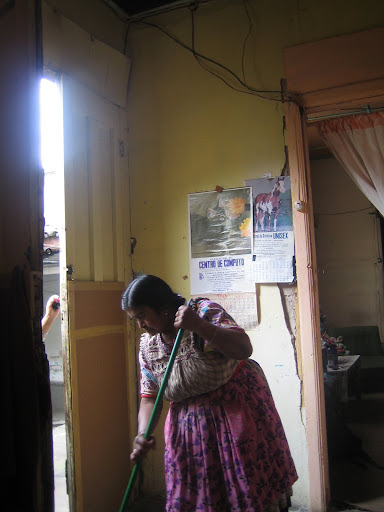
Whoops!
A few seconds later Martha and Liz, ignorant of the events that just took place, come leisurely around the corner. I was still standing in the doorway, mouth wide open and stunned that there were actually pieces of the wall around my feet. I felt horrible.
Liz, attempting to console her saddened husband, proceeded to fall on the floor laughing. Martha took a moment to assess the situation before joining in...whew! Angela, hearing all of the commotion, came to see what was going on and, of course, joined in.
I can't tell you how many times I said "lo siento" the rest of the day. But Martha just took it in stride and told us that the next morning she would go talk to the carpenter across the street while we were on our Volcanic adventure (Of course the carpenter lives across the street...but hopefully she didn't feel the need to see the lawyer next door to him.)
It made for a lively conversation at lunch, during which I earned the nickname "super hombre" among others. Angela continues to make fun of me to this day.
When we got back from the Volcano on Saturday afternoon, the door frame and wall had already been repaired. All things considered, minor costs for a great story.
 all better!
all better!
